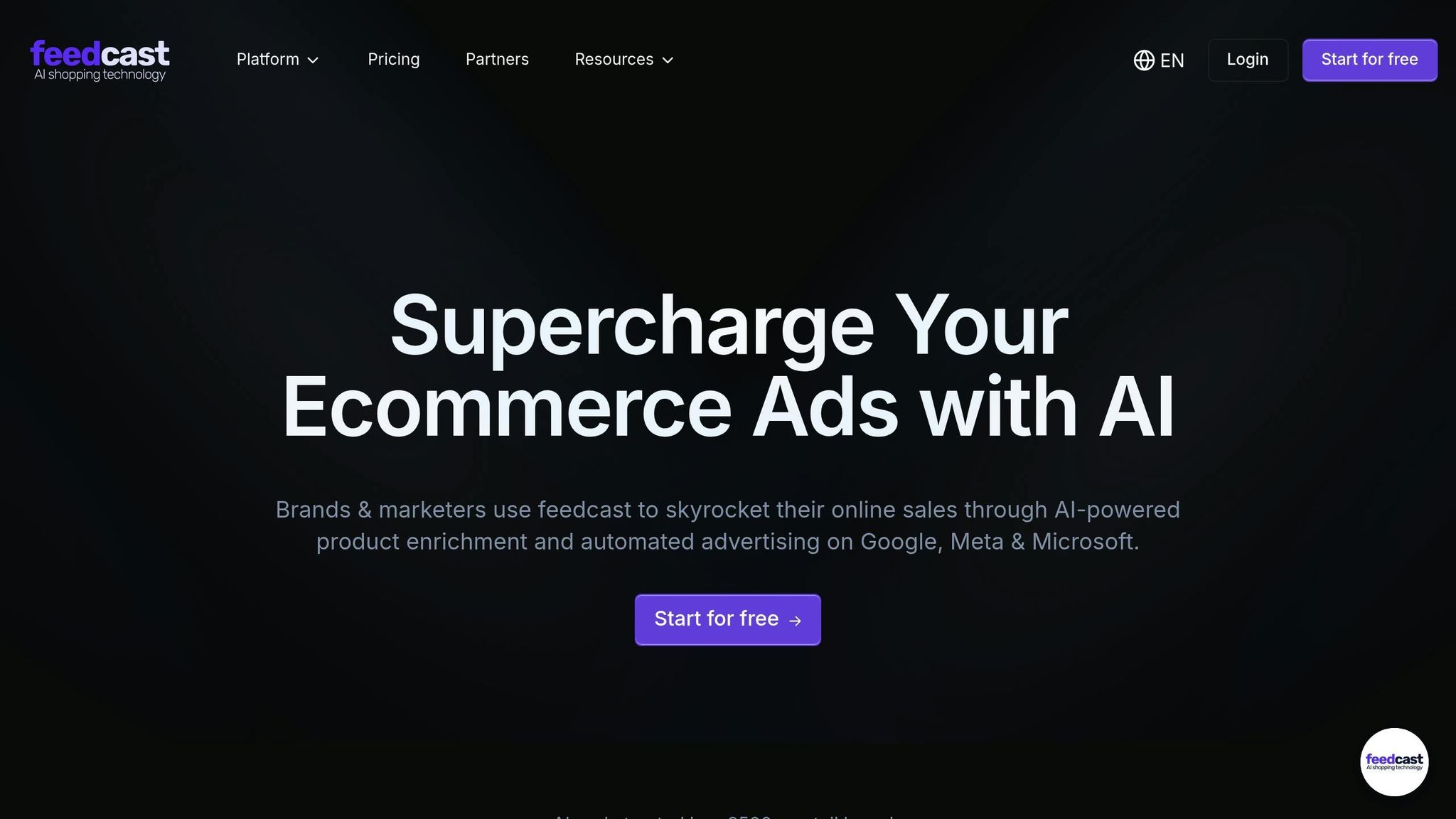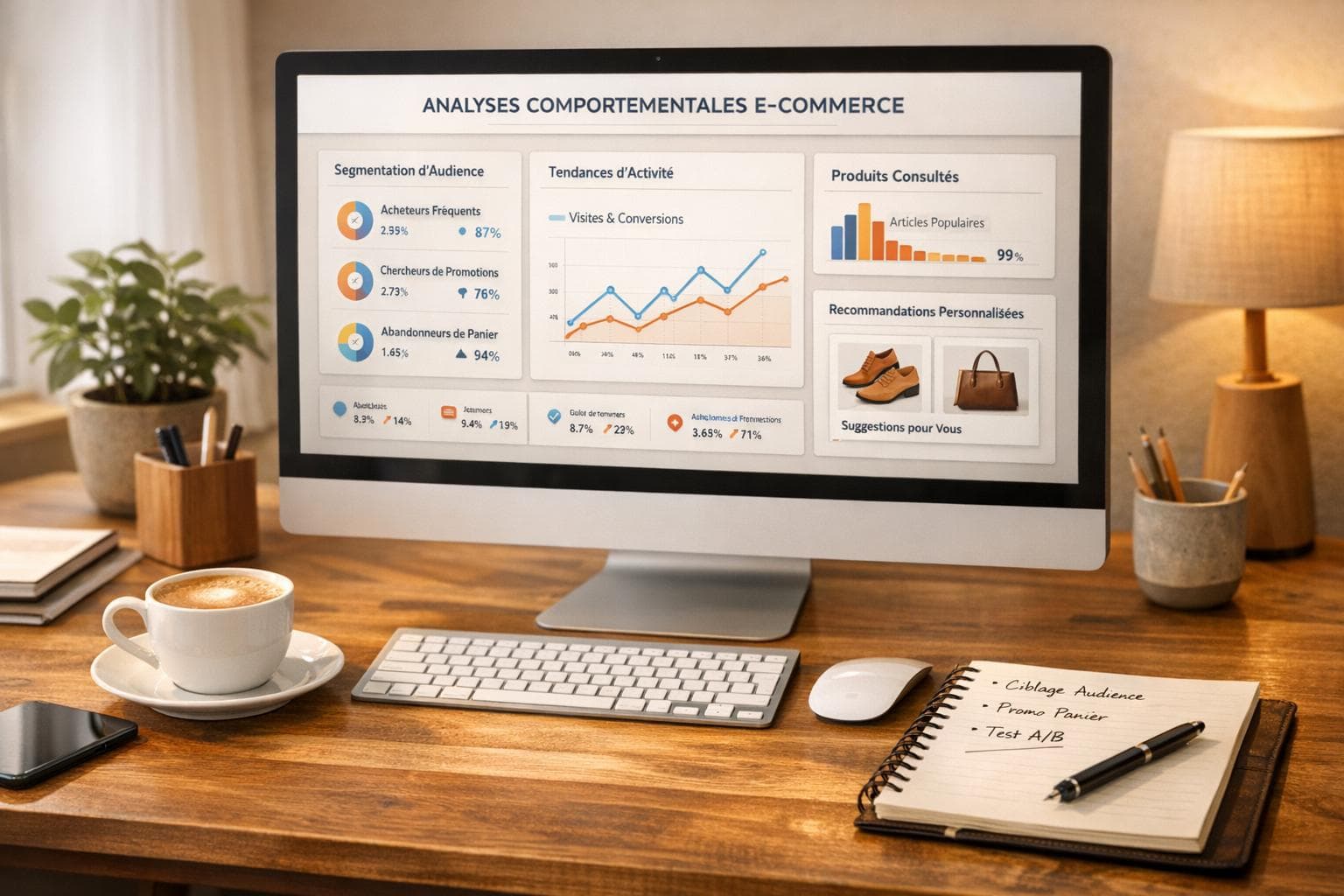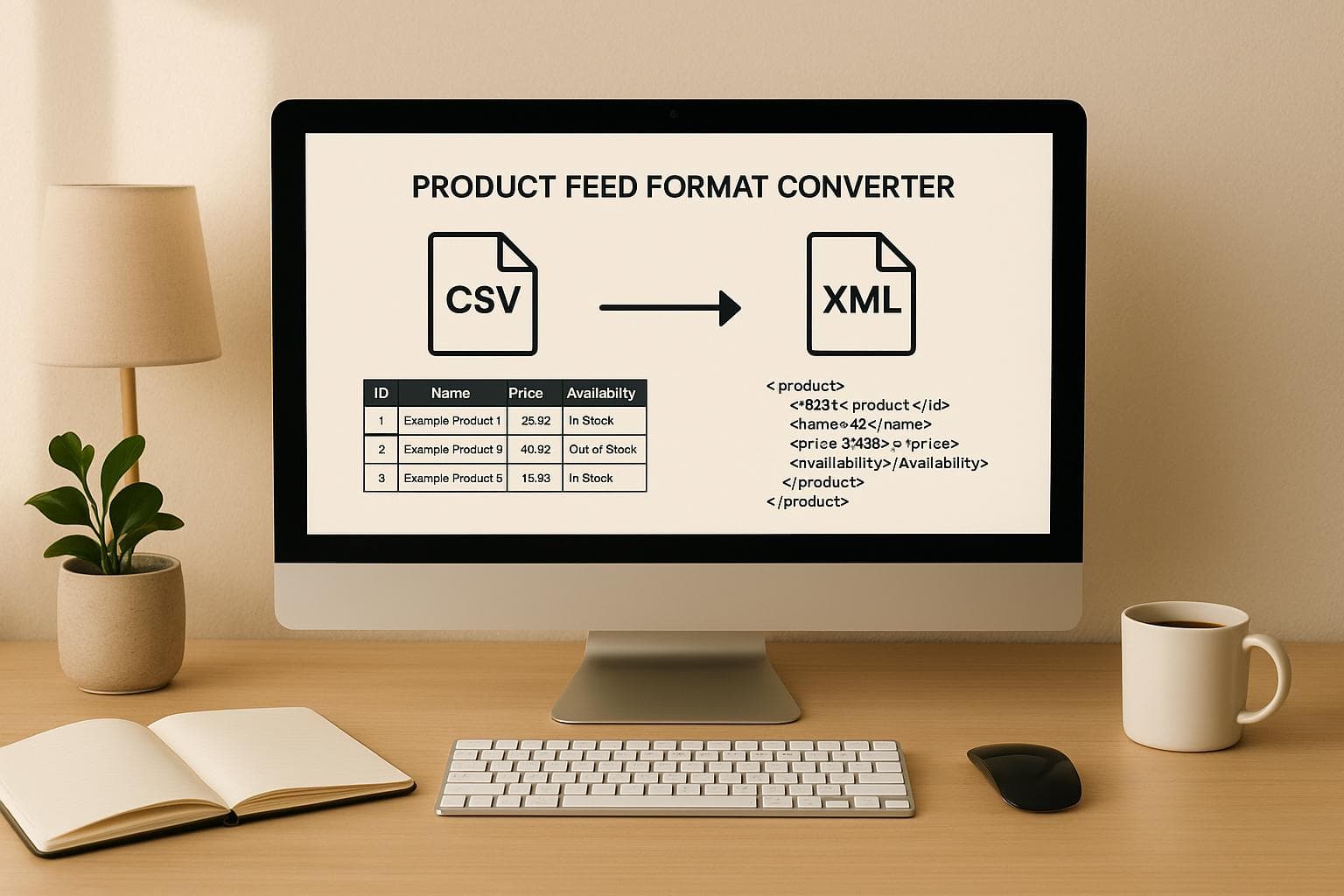How AI Improves CLV in E-commerce Ads
Explore how AI enhances customer lifetime value in e-commerce by optimizing targeting, personalization, and campaign management.
AI is transforming how e-commerce businesses increase Customer Lifetime Value (CLV). By using advanced data analysis and automation, AI helps companies identify high-value customers, predict behaviors, and create personalized ads that drive long-term loyalty and revenue.
Key takeaways from the article:
- What is CLV? It measures the total profit a customer generates over their relationship with a brand.
- Why focus on CLV? Businesses prioritizing CLV over one-time sales can see up to a 20% revenue boost.
- How AI helps: AI predicts customer behavior, delivers personalized campaigns, and optimizes ad spend in real time.
- Results with AI: Companies report up to 40% better retention, 25% higher order values, and 75% sales growth.
- Tools like Feedcast: Platforms integrate ad channels, enhance product feeds, and provide real-time analytics to improve CLV.
AI-powered strategies are reshaping e-commerce marketing by delivering smarter targeting, personalized experiences, and better campaign management, all leading to stronger customer relationships and higher profits.
Elevating E-Commerce: Valentin Radu's Blueprint for Customer Value Optimization and Future Insights
AI Targeting for High-Value Customers
Traditional customer segmentation often relies on basic factors like demographics or purchase history. AI takes this a step further by diving into complex behavioral patterns to pinpoint customers with the highest potential lifetime value. This allows businesses to focus their advertising budgets on the most profitable opportunities.
Finding High-Value Customer Segments with AI
AI algorithms excel at uncovering patterns that traditional methods often miss. By analyzing browsing habits, purchase behavior, and demographic data, AI creates detailed customer profiles that go far beyond surface-level insights [3]. These systems can detect subtle trends, such as the timing of purchases, preferences for certain product categories, and engagement levels with different touchpoints [4].
The impact is clear. AI-driven customer segmentation has been shown to boost sales from personalized recommendations by 35% [3]. Businesses using AI for segmentation often report significant benefits: conversion rates improve by 20–30%, average order values grow by 10–15%, and customer retention increases by 25% when strategies align with customer expectations [4].
Amazon is a standout example. By leveraging customer browsing and purchase data, the company generates 35% of its sales through product recommendations [3]. AI also enables businesses to discover micro-segments that traditional methods might overlook, opening doors to highly targeted marketing campaigns [5].
This level of precision sets the stage for real-time adjustments, keeping ads relevant to evolving high-value audiences.
Real-Time Audience Adjustments
Once segmentation is refined, AI takes it further by continuously updating customer profiles to reflect real-time behaviors. In today’s fast-paced e-commerce world, static customer segments quickly become outdated. AI systems adapt by integrating fresh behavioral data and market trends, ensuring your engagement strategies stay relevant [8].
Zara is a prime example of this adaptability. The fashion retailer employs AI to analyze factors like purchase history, browsing habits, social media interactions, and even local weather data. This enables the creation of micro-segments tailored for personalized marketing, product suggestions, and landing pages [6]. As customer behaviors shift, Zara’s AI agents evolve, leading to higher conversion rates, larger order values, and stronger customer loyalty [6].
To make real-time adjustments work, it’s essential to map your data flows correctly. This means ensuring your AI tools can access all relevant data sources, including your website, mobile app, email campaigns, and social media platforms [7]. With this integration, AI can instantly act on insights, delivering coordinated strategies across all channels.
AI’s ability to adapt on the fly ensures businesses can respond to customer needs in real time, unifying performance data for smarter targeting decisions [7].
Benefits of AI Targeting
When precise segmentation and real-time adjustments come together, the results are impressive. Companies that excel at personalization see a 40% boost in revenue from targeted activities [4]. AI enables businesses to predict customer actions, shifting from reactive to proactive engagement [5].
The financial returns are undeniable. AI-driven personalization delivers an average return of $3.70 for every dollar invested [3]. Instead of casting a wide net, AI ensures your ads reach customers who are genuinely likely to become long-term, high-value buyers.
Netflix offers a great example of this in action. The streaming giant uses AI to predict viewing preferences and provide tailored content recommendations, leading to higher customer engagement and retention [9]. Their system also identifies users at risk of canceling and adjusts recommendations to keep them engaged.
Beyond immediate sales, the benefits of AI targeting extend to building trust and loyalty. 66% of customers expect businesses to understand their unique needs and preferences [4]. By delivering relevant ads and offers, AI helps foster trust, encouraging repeat purchases and boosting customer lifetime value.
Businesses that use AI to predict customer behavior report impressive results, including a 25% increase in sales and a 30% jump in customer satisfaction [10]. Over time, these satisfied customers often become brand advocates, driving even more value through referrals and repeat business.
Personalization and Predictive Analytics
AI doesn't just improve targeting - it reshapes the entire customer journey by turning data into actionable insights. This means businesses can predict customer needs and deliver tailored experiences, ultimately enhancing long-term customer value.
Predicting Customer Behavior and Needs
AI taps into historical and multichannel data to forecast customer behavior, refining its predictions as fresh data rolls in [11]. With machine learning algorithms constantly evolving, businesses can stay one step ahead, anticipating what their customers want before they even ask [11]. For instance, AI can identify when a customer is at risk of leaving by analyzing engagement patterns and behavioral signals [11].
It goes deeper too. AI calculates Customer Lifetime Value (CLV) by examining factors like purchase frequency, average spend, and retention rates [11]. It can even pinpoint opportunities for cross-selling and upselling by predicting which products or services a customer might want, based on their interactions across various platforms [11]. For example, an online retailer might notice a user frequently browsing a specific product category. AI can step in, suggesting personalized product recommendations or exclusive discounts to nudge the customer toward making a purchase [11].
These insights pave the way for the next stage: crafting ads that speak directly to individual preferences.
Creating Personalized Ads for Better Retention
Once AI understands customer behavior, it can design advertising experiences tailored to each individual. By analyzing preferences and habits, AI helps businesses create marketing that feels personal and relevant [12]. A great example is Sephora, which uses AI-powered chatbots to answer customer questions and provide beauty recommendations tailored to each shopper [12].
The magic lies in personalizing every interaction. AI-driven tools can generate dynamic ad variations that cater to specific customer segments, ensuring that marketing efforts resonate on a deeper level [11].
How Personalization Increases CLV
When predictions and personalized ads come together, the result is stronger customer relationships and optimized lifetime value. Customers who receive offers and recommendations that align with their interests are more likely to return, make repeat purchases, and develop loyalty to the brand.
Personalized marketing doesn’t just boost retention - it also reduces acquisition costs and increases the average order value by delivering the right offer at the right time. The key is making these interactions feel genuine, not automated, which fosters trust and long-term loyalty.
"Your job will not be taken by AI. It will be taken by a person who knows how to use AI." – Christina Inge, Author of Marketing Analytics: A Comprehensive Guide and Marketing Metrics and instructor at Harvard's Division of Continuing Education [12]
To succeed, businesses need high-quality data from diverse sources and a commitment to refining predictions as new information becomes available [11]. The more data AI can analyze, the sharper its predictions, leading to better personalization and enhanced customer lifetime value.
sbb-itb-0bd1697
AI Campaign Optimization
AI isn't just about personalizing ads or honing in on the right audience - it’s also a game-changer for campaign optimization. By automating tasks like bid adjustments and budget allocation, it frees marketers to focus on big-picture strategies. This kind of automation enables campaigns to adapt in real time, driving better results and maximizing customer lifetime value (CLV).
Automated Campaign and Bid Management
Think about the hours marketers used to spend tweaking bids and budgets. AI now handles these tasks seamlessly. It adjusts bids in real time based on performance data, competitive trends, and user behavior patterns [14]. When a campaign performs well, AI increases bids and budgets to capture more high-value customers. During slower periods, it dials back spending to protect profit margins [13].
AI doesn’t stop there. It analyzes multiple variables - like time of day, device type, and media platform - to determine the best bid for every auction [16]. This approach ensures campaigns remain effective across different contexts without constant manual oversight.
Budget allocation is another area where AI shines. It dynamically shifts resources to top-performing channels, campaigns, or products. For example, if one platform is driving more conversions than another, AI reallocates the budget on the fly, saving marketers from having to analyze and act manually [14].
The results speak for themselves. Over 60% of e-commerce marketers now use AI or automation in their ad strategies, and they report 20–30% higher returns. One retailer even achieved a 240% improvement in return on ad spend (ROAS) and reduced their cost per conversion by 77.21% [13][14].
Real-Time Performance Dashboards
Traditional campaign reporting often involves tedious tasks like pulling data from multiple platforms and analyzing it days after the fact. AI-powered dashboards eliminate these delays by providing real-time access to all your campaign metrics in one place.
These dashboards not only display data instantly but also interpret it. AI can identify performance shifts within minutes and suggest immediate adjustments [14]. For instance, if a product suddenly starts converting at a higher rate, the system flags the trend and may recommend increasing the budget - giving marketers a competitive edge.
This level of speed is crucial for maximizing CLV. Unlike manual adjustments, which might happen once a day or even weekly, AI optimizes continuously [14]. Key metrics like cost per acquisition (CPA), click-through rate (CTR), and return on investment (ROI) are updated in real time, allowing for faster, data-driven decisions [15]. Additionally, AI helps pinpoint profitable keywords and product ASINs, expanding targeting opportunities without requiring hours of manual research [17].
Manual vs. AI Campaign Management
AI doesn’t just automate tasks - it transforms how campaigns are managed. While manual methods rely on human effort and often focus on broad audience groups, AI scales effortlessly, analyzing thousands of customer segments simultaneously. This allows for detailed CLV calculations and highly targeted optimizations [18].
AI also excels at identifying subtle patterns in customer behavior that manual analysis might miss. These insights lead to more accurate predictions about customer behavior and lifetime value [18]. Companies leveraging AI analytics are 2.5 times more likely to outperform their competitors in both customer retention and acquisition. On average, businesses that adopt AI-driven CLV strategies see a 25% revenue boost and a 30% drop in customer churn [18].
A real-world example? In 2024, Turkish retailer Boyner adopted AI-powered strategies for acquiring high-value customers. The results were striking: a 240% increase in new customers, a 310% rise in CLV, and a 20% reduction in acquisition costs [19].
It’s important to note that while AI optimizes execution, humans remain essential for setting goals and priorities [13]. Marketers decide which customer segments to focus on and what messaging resonates best, while AI handles the tactical work.
For businesses ready to dive into AI-driven campaign optimization, the first step is clear: define your campaign goals upfront [15]. Whether the aim is to maximize CLV, lower acquisition costs, or improve retention, having clear objectives allows AI tools to fine-tune strategies effectively. From there, the technology continues to refine performance, ensuring your campaigns stay aligned with your priorities.
Feedcast: Multi-Channel Advertising Platform

Running ad campaigns across multiple platforms while aiming to boost customer lifetime value can feel like juggling too many balls at once. Feedcast simplifies this process by combining Google, Meta (Facebook and Instagram), and Microsoft Ads into one AI-driven dashboard. This unified platform helps e-commerce businesses streamline their advertising efforts and focus on building long-term customer relationships.
Managing Multiple Ad Platforms
Jumping between different ad platforms often leads to inconsistent messaging and wasted time. Feedcast eliminates this hassle by bringing all major ad accounts into one place. With its centralized dashboard, you can oversee Google Shopping campaigns, Facebook product ads, and Microsoft Ads performance without switching between platforms.
This approach not only saves time but also reduces manual errors that come with managing campaigns separately. For businesses in the U.S., the platform makes budget management straightforward by using familiar formats like USD currency, MM/DD/YYYY dates, and standard number formatting (commas for thousands, periods for decimals). When market conditions change, you can quickly adjust campaigns across all platforms without logging into multiple accounts.
What makes this setup invaluable is the ability to see a complete view of customer interactions across channels. Instead of analyzing data in silos, you can identify which platforms bring in your most valuable customers. This insight helps you allocate resources effectively and sets the stage for improving product feeds to enhance ad performance.
AI Product Feed Enhancement
Even the most well-planned ad campaigns can fall flat if your product data isn’t up to par. Feedcast addresses this by using AI to refine product titles, descriptions, and other details, ensuring your listings stand out in crowded marketplaces. This goes beyond simple formatting tweaks - it optimizes your product information to align with what potential customers are searching for.
The AI system automatically fixes common issues like missing attributes, incorrect formatting, or incomplete descriptions. These improvements ensure your products qualify for all relevant ad placements, boosting visibility and sales potential. Better product feeds lead to higher-quality listings, which ad algorithms reward with increased exposure and better click-through rates [1].
For example, a basic title like "Blue Shirt Size M" can be transformed into something more search-friendly, attracting the right audience. Feedcast also integrates seamlessly with platforms like Shopify, WooCommerce, and Prestashop. You can upload data through Google Sheets, CSV files, or XML formats, giving you the flexibility to manage your inventory however you prefer.
Analytics and Smart Targeting Features
Real-time analytics are a game-changer for optimizing ad spend and boosting customer lifetime value. With Feedcast, you can pinpoint high-performing campaigns and quickly address those that aren’t meeting expectations.
The platform's AI-powered targeting tools excel at identifying high-value customer segments. By analyzing past purchase data and real-time behaviors, Feedcast segments customers by value and predicts future spending patterns. This enables highly targeted campaigns, such as personalized offers or retargeting ads, aimed at customers most likely to drive long-term revenue.
Performance segmentation provides a clear picture of which products and audiences deliver the best results. You’ll know exactly which customer groups have the highest lifetime value, allowing you to fine-tune your marketing strategy for maximum impact. This focus on high-value customers not only improves efficiency but also boosts your return on investment.
According to industry data, businesses using AI-powered platforms like Feedcast see up to 15% better retention rates and 20% higher average order values through personalized marketing and smarter targeting [20]. By combining real-time analytics with predictive tools, Feedcast helps businesses make data-driven decisions that continuously improve customer lifetime value.
Flexible pricing plans, including a free tier, ensure that these powerful tools are accessible to businesses of all sizes.
Conclusion
AI has reshaped how e-commerce businesses approach customer lifetime value (CLV), delivering results that surpass traditional advertising methods. Companies using AI-driven CLV analysis report an average 25% boost in customer retention and a 15% increase in revenue growth [21]. Even more compelling, businesses leveraging AI-powered CLV prediction achieve an average ROI of 245% within three years [21].
The real-world impact is hard to ignore. For example, Yum Brands adopted an AI-powered CLV platform, which helped them significantly enhance customer loyalty and sales through precise marketing campaigns and personalized offers [21]. Similarly, Stitch Fix reduced customer churn by 20% and increased average order value by 15% using AI-driven CLV insights [21].
What stands out most is AI’s ability to tackle the challenge of personalization at scale. With 80% of customers more likely to buy from brands offering personalized experiences [21], AI empowers businesses to meet these expectations without overwhelming their marketing teams.
The adoption of AI in e-commerce is accelerating rapidly. Seventy-five percent of businesses plan to invest in AI-powered CLV prediction within the next two years [2], while AI adoption in the sector has already grown by 30% in the past year [2]. Staying competitive increasingly means embracing these technologies.
Platforms like Feedcast are making AI tools accessible to businesses of all sizes. With flexible pricing, including a free tier, and scalable options for unlimited products and channels, even small and medium-sized e-commerce stores can benefit. The platform’s 20% savings on Google Shopping CPC [22] alone can offset implementation costs while delivering the precision and personalization needed to maximize long-term customer value.
AI isn’t just enhancing CLV - it’s redefining the possibilities in e-commerce advertising. By integrating AI for targeting, personalization, and optimization, businesses can fully unlock the potential of CLV insights and drive sustainable growth.
FAQs
How does AI improve the accuracy of predicting customer lifetime value (CLV) in e-commerce?
AI enhances the precision of predicting customer lifetime value (CLV) by processing massive amounts of customer data and uncovering patterns that traditional methods often miss. Through machine learning, AI combines data from various sources - like purchase history, browsing habits, and engagement metrics - to deliver more accurate forecasts.
This capability helps e-commerce businesses create better customer segments, fine-tune marketing strategies, and allocate resources to areas with the highest potential impact. With this approach, businesses can improve targeting, offer personalized experiences, and confidently maximize long-term customer value.
How can e-commerce businesses use AI to create effective customer segments?
To build effective customer segments using AI, start by setting clear, actionable goals that align with your marketing strategy. For example, are you aiming to boost sales, improve customer retention, or enhance engagement? Defining these objectives upfront helps guide the entire process.
Next, collect high-quality data from every customer interaction. This could include purchase history, website behavior, and CRM records. Make sure your data is clean, well-organized, and integrated across platforms - accurate data is the foundation for meaningful insights.
Once your data is ready, apply machine learning techniques like clustering algorithms (e.g., K-means) to identify patterns and group customers into relevant segments. These algorithms analyze behaviors and preferences, helping you uncover connections you might otherwise miss.
Finally, don’t stop there - AI models need regular monitoring and fine-tuning to keep up with evolving customer behaviors. When done right, AI-powered segmentation allows you to create dynamic, personalized customer groups that improve targeting, boost ad performance, and maximize customer lifetime value.
How can small and medium-sized e-commerce businesses use AI tools like Feedcast to boost customer loyalty and grow revenue?
Small and medium-sized e-commerce businesses can use AI tools like Feedcast to compete more effectively with larger companies by automating and improving their advertising strategies. With features like personalized ad creation and smart targeting, businesses can create ads that connect with customers on a deeper level, encouraging loyalty and repeat purchases.
Feedcast also streamlines campaign management by bringing multiple advertising channels into a single platform. This not only saves time but also reduces the hassle of juggling different tools. Plus, with access to detailed analytics and performance insights, businesses can make smarter, data-backed decisions to fine-tune their strategies and boost their ROI. These tools give smaller e-commerce brands the chance to stand out, keep customers engaged, and drive consistent growth.
Geoffrey G.










